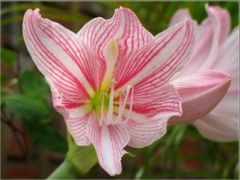Tuberose
| Infobox on Tuberose | |
|---|---|
| Example of Tuberose |  |
| Facts | |
| Origin | - |
| Stowage factor (in m3/t) | - |
| Humidity / moisture | - |
| Ventilation | - |
| Risk factors | See text |
Tuberose
Contents
Description / Shipment / Storage / Risk factors
Scientific Name and Introduction
Polianthes tuberose. Spikes of ivory flowers much prized in the East for their fragrance and by western florists for accents and bridal bouquets, tuberose flowers bear as many as 50 florets, in pairs, on a tall spike. The postharvest life of these flowers typically is limited by failure of developing buds to open, so that the life is determined by the life of the flowers that were open at harvest. Proper pre-treatments can greatly extend the life of tuberose, and should routinely be carried out with flowers intended for storage and transport.
Quality Characteristics and Criteria
The flowers are normally harvested with two to four open blooms on the spike. Although earlier harvest provides a spike that is more resistant to transportation, the buds are unlikely to open after transport unless properly pre-treated. Flowers for the local market may be harvested with more open flowers on the spike. It is unfortunately difficult to determine whether tuberose flowers have been effectively pre-treated prior to purchase. Look for straight stems, unblemished blooms, and work with your supplier to ensure that the flowers have been properly pretreated.
Grading and Bunching
Tuberose are sold in bunches of 10 stems.
Ethylene Sensitivity
Floret opening is reduced in spikes exposed to high concentrations of ethylene, but this effect is probably not normally of commercial significance, so 1-MCP or STS treatments are not warranted for tuberose.
Pretreatments
Tuberose flowers should be pulsed for 24 h at 20°C to 25°C with a preservative solution augmented with 20% sucrose. This pretreatment will significantly improve vase-life and opening of buds on the flower spikes. Flowers to be pre-treated in this way should preferably be harvested dry, graded, bunched, and re-cut, then placed immediately in the pulsing solution.
Storage Conditions
The optimal temperature for cooling and storage of tuberose is 0ºC, but after only short periods, the buds on the spike fail to open. Pulse pre-treatment with sucrose overcomes this problem, and after 6 days storage, flowers open as well as freshly-cut spikes.
Packing
Tuberose may be packed in hampers or in horizontal fibreboard boxes. If packed horizontal, they should be held at the proper temperature to avoid geotropic curvature.
Special Considerations
Florists often use individual tuberose blooms in corsages and boutonnieres. Proper pre-treatment of the spikes will ensure continued opening of the blooms in the florists’ workroom and consequent increased utility of each spike.
Sources used
BMT Consolidated Manual on (Dutch) Flower Bulbs, cut flowers/greens and potted plants.











